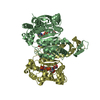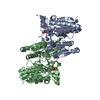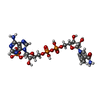[English] 日本語
 Yorodumi
Yorodumi- PDB-5k11: Cryo-EM structure of isocitrate dehydrogenase (IDH1) in inhibitor... -
+ Open data
Open data
- Basic information
Basic information
| Entry | Database: PDB / ID: 5k11 | ||||||
|---|---|---|---|---|---|---|---|
| Title | Cryo-EM structure of isocitrate dehydrogenase (IDH1) in inhibitor-bound state | ||||||
 Components Components | Isocitrate dehydrogenase [NADP] cytoplasmic | ||||||
 Keywords Keywords |  OXIDOREDUCTASE / OXIDOREDUCTASE /  isocitrate dehydrogenase / small metabolic complex / small molecule inhibitor isocitrate dehydrogenase / small metabolic complex / small molecule inhibitor | ||||||
| Function / homology |  Function and homology information Function and homology informationAbnormal conversion of 2-oxoglutarate to 2-hydroxyglutarate / NADPH regeneration / regulation of phospholipid catabolic process / regulation of phospholipid biosynthetic process / NFE2L2 regulating TCA cycle genes / isocitrate metabolic process /  isocitrate dehydrogenase (NADP+) / isocitrate dehydrogenase (NADP+) /  isocitrate dehydrogenase (NADP+) activity / 2-oxoglutarate metabolic process / NADP metabolic process ...Abnormal conversion of 2-oxoglutarate to 2-hydroxyglutarate / NADPH regeneration / regulation of phospholipid catabolic process / regulation of phospholipid biosynthetic process / NFE2L2 regulating TCA cycle genes / isocitrate metabolic process / isocitrate dehydrogenase (NADP+) activity / 2-oxoglutarate metabolic process / NADP metabolic process ...Abnormal conversion of 2-oxoglutarate to 2-hydroxyglutarate / NADPH regeneration / regulation of phospholipid catabolic process / regulation of phospholipid biosynthetic process / NFE2L2 regulating TCA cycle genes / isocitrate metabolic process /  isocitrate dehydrogenase (NADP+) / isocitrate dehydrogenase (NADP+) /  isocitrate dehydrogenase (NADP+) activity / 2-oxoglutarate metabolic process / NADP metabolic process / isocitrate dehydrogenase (NADP+) activity / 2-oxoglutarate metabolic process / NADP metabolic process /  glyoxylate cycle / response to steroid hormone / female gonad development / peroxisomal matrix / glutathione metabolic process / glyoxylate cycle / response to steroid hormone / female gonad development / peroxisomal matrix / glutathione metabolic process /  tricarboxylic acid cycle / tricarboxylic acid cycle /  Peroxisomal protein import / Peroxisomal protein import /  peroxisome / NAD binding / tertiary granule lumen / peroxisome / NAD binding / tertiary granule lumen /  NADP binding / secretory granule lumen / response to oxidative stress / ficolin-1-rich granule lumen / NADP binding / secretory granule lumen / response to oxidative stress / ficolin-1-rich granule lumen /  cadherin binding / Neutrophil degranulation / magnesium ion binding / protein homodimerization activity / cadherin binding / Neutrophil degranulation / magnesium ion binding / protein homodimerization activity /  mitochondrion / extracellular exosome / extracellular region / identical protein binding / mitochondrion / extracellular exosome / extracellular region / identical protein binding /  cytosol / cytosol /  cytoplasm cytoplasmSimilarity search - Function | ||||||
| Biological species |   Homo sapiens (human) Homo sapiens (human) | ||||||
| Method |  ELECTRON MICROSCOPY / ELECTRON MICROSCOPY /  single particle reconstruction / single particle reconstruction /  cryo EM / Resolution: 3.8 Å cryo EM / Resolution: 3.8 Å | ||||||
 Authors Authors | Merk, A. / Bartesaghi, A. / Banerjee, S. / Falconieri, V. / Rao, P. / Earl, L. / Milne, J. / Subramaniam, S. | ||||||
 Citation Citation |  Journal: Cell / Year: 2016 Journal: Cell / Year: 2016Title: Breaking Cryo-EM Resolution Barriers to Facilitate Drug Discovery. Authors: Alan Merk / Alberto Bartesaghi / Soojay Banerjee / Veronica Falconieri / Prashant Rao / Mindy I Davis / Rajan Pragani / Matthew B Boxer / Lesley A Earl / Jacqueline L S Milne / Sriram Subramaniam /  Abstract: Recent advances in single-particle cryoelecton microscopy (cryo-EM) are enabling generation of numerous near-atomic resolution structures for well-ordered protein complexes with sizes ≥ ∼200 kDa. ...Recent advances in single-particle cryoelecton microscopy (cryo-EM) are enabling generation of numerous near-atomic resolution structures for well-ordered protein complexes with sizes ≥ ∼200 kDa. Whether cryo-EM methods are equally useful for high-resolution structural analysis of smaller, dynamic protein complexes such as those involved in cellular metabolism remains an important question. Here, we present 3.8 Å resolution cryo-EM structures of the cancer target isocitrate dehydrogenase (93 kDa) and identify the nature of conformational changes induced by binding of the allosteric small-molecule inhibitor ML309. We also report 2.8-Å- and 1.8-Å-resolution structures of lactate dehydrogenase (145 kDa) and glutamate dehydrogenase (334 kDa), respectively. With these results, two perceived barriers in single-particle cryo-EM are overcome: (1) crossing 2 Å resolution and (2) obtaining structures of proteins with sizes < 100 kDa, demonstrating that cryo-EM can be used to investigate a broad spectrum of drug-target interactions and dynamic conformational states. | ||||||
| History |
|
- Structure visualization
Structure visualization
| Movie |
 Movie viewer Movie viewer |
|---|---|
| Structure viewer | Molecule:  Molmil Molmil Jmol/JSmol Jmol/JSmol |
- Downloads & links
Downloads & links
- Download
Download
| PDBx/mmCIF format |  5k11.cif.gz 5k11.cif.gz | 302.5 KB | Display |  PDBx/mmCIF format PDBx/mmCIF format |
|---|---|---|---|---|
| PDB format |  pdb5k11.ent.gz pdb5k11.ent.gz | 249.8 KB | Display |  PDB format PDB format |
| PDBx/mmJSON format |  5k11.json.gz 5k11.json.gz | Tree view |  PDBx/mmJSON format PDBx/mmJSON format | |
| Others |  Other downloads Other downloads |
-Validation report
| Arichive directory |  https://data.pdbj.org/pub/pdb/validation_reports/k1/5k11 https://data.pdbj.org/pub/pdb/validation_reports/k1/5k11 ftp://data.pdbj.org/pub/pdb/validation_reports/k1/5k11 ftp://data.pdbj.org/pub/pdb/validation_reports/k1/5k11 | HTTPS FTP |
|---|
-Related structure data
| Related structure data |  8193MC  8191C  8192C  8194C  5k0zC  5k10C  5k12C M: map data used to model this data C: citing same article ( |
|---|---|
| Similar structure data |
- Links
Links
- Assembly
Assembly
| Deposited unit | 
|
|---|---|
| 1 |
|
- Components
Components
| #1: Protein | Mass: 46334.742 Da / Num. of mol.: 2 Source method: isolated from a genetically manipulated source Source: (gene. exp.)   Homo sapiens (human) / Gene: IDH1, PICD / Production host: Homo sapiens (human) / Gene: IDH1, PICD / Production host:  unidentified baculovirus unidentified baculovirusReferences: UniProt: O75874,  isocitrate dehydrogenase (NADP+) isocitrate dehydrogenase (NADP+)#2: Chemical |  Nicotinamide adenine dinucleotide phosphate Nicotinamide adenine dinucleotide phosphate |
|---|
-Experimental details
-Experiment
| Experiment | Method:  ELECTRON MICROSCOPY ELECTRON MICROSCOPY |
|---|---|
| EM experiment | Aggregation state: PARTICLE / 3D reconstruction method:  single particle reconstruction single particle reconstruction |
- Sample preparation
Sample preparation
| Component | Name: Isocitrate dehydrogenase R132C mutant in complex with ML309 Type: COMPLEX / Entity ID: #1 / Source: RECOMBINANT | ||||||||||||||||||||
|---|---|---|---|---|---|---|---|---|---|---|---|---|---|---|---|---|---|---|---|---|---|
| Molecular weight | Value: 0.093 MDa / Experimental value: NO | ||||||||||||||||||||
| Source (natural) | Organism:   Homo sapiens (human) Homo sapiens (human) | ||||||||||||||||||||
| Source (recombinant) | Organism:  unidentified baculovirus / Plasmid unidentified baculovirus / Plasmid : unknown : unknown | ||||||||||||||||||||
| Buffer solution | pH: 7.5 | ||||||||||||||||||||
| Buffer component |
| ||||||||||||||||||||
| Specimen | Conc.: 2.8 mg/ml / Embedding applied: NO / Shadowing applied: NO / Staining applied : NO / Vitrification applied : NO / Vitrification applied : YES : YES | ||||||||||||||||||||
| Specimen support | Grid material: COPPER / Grid mesh size: 300 divisions/in. / Grid type: Quantifoil R1.2/1.3 | ||||||||||||||||||||
Vitrification | Instrument: LEICA EM GP / Cryogen name: ETHANE / Details: Plunged into liquid ethane (LEICA EM GP) |
- Electron microscopy imaging
Electron microscopy imaging
| Experimental equipment |  Model: Titan Krios / Image courtesy: FEI Company |
|---|---|
| Microscopy | Model: FEI TITAN KRIOS |
| Electron gun | Electron source : :  FIELD EMISSION GUN / Accelerating voltage: 300 kV / Illumination mode: FLOOD BEAM FIELD EMISSION GUN / Accelerating voltage: 300 kV / Illumination mode: FLOOD BEAM |
| Electron lens | Mode: BRIGHT FIELD Bright-field microscopy / Nominal magnification: 270000 X / Calibrated magnification: 101000 X / Nominal defocus max: 2600 nm / Nominal defocus min: 700 nm / Cs Bright-field microscopy / Nominal magnification: 270000 X / Calibrated magnification: 101000 X / Nominal defocus max: 2600 nm / Nominal defocus min: 700 nm / Cs : 2.7 mm : 2.7 mm |
| Specimen holder | Cryogen: NITROGEN / Specimen holder model: FEI TITAN KRIOS AUTOGRID HOLDER / Temperature (max): 79.8 K / Temperature (min): 79.6 K |
| Image recording | Average exposure time: 0.2 sec. / Electron dose: 60 e/Å2 / Detector mode: SUPER-RESOLUTION / Film or detector model: GATAN K2 QUANTUM (4k x 4k) / Num. of real images: 820 |
| EM imaging optics | Energyfilter name : GIF Quantum / Energyfilter upper: 20 eV / Energyfilter lower: 0 eV : GIF Quantum / Energyfilter upper: 20 eV / Energyfilter lower: 0 eV |
| Image scans | Movie frames/image: 60 / Used frames/image: 0-29 |
- Processing
Processing
| Software | Name: PHENIX / Version: 1.10.1_2155: / Classification: refinement | ||||||||||||||||||||||||||||||||
|---|---|---|---|---|---|---|---|---|---|---|---|---|---|---|---|---|---|---|---|---|---|---|---|---|---|---|---|---|---|---|---|---|---|
| EM software |
| ||||||||||||||||||||||||||||||||
CTF correction | Type: PHASE FLIPPING AND AMPLITUDE CORRECTION | ||||||||||||||||||||||||||||||||
| Particle selection | Num. of particles selected: 232343 | ||||||||||||||||||||||||||||||||
| Symmetry | Point symmetry : C2 (2 fold cyclic : C2 (2 fold cyclic ) ) | ||||||||||||||||||||||||||||||||
3D reconstruction | Resolution: 3.8 Å / Resolution method: FSC 0.143 CUT-OFF / Num. of particles: 46483 / Algorithm: FOURIER SPACE Details: The primary map for this entry corresponds to the uncorrected reconstruction. A version sharpened using a B-factor of -180 is provided as additional volume data. The reconstruction, obtained ...Details: The primary map for this entry corresponds to the uncorrected reconstruction. A version sharpened using a B-factor of -180 is provided as additional volume data. The reconstruction, obtained without imposing symmetry, is also provided with this entry as additional volume data. Symmetry type: POINT | ||||||||||||||||||||||||||||||||
| Atomic model building | Protocol: FLEXIBLE FIT / Space: REAL | ||||||||||||||||||||||||||||||||
| Refinement | Highest resolution: 3.8 Å | ||||||||||||||||||||||||||||||||
| Refine LS restraints |
|
 Movie
Movie Controller
Controller












 PDBj
PDBj





